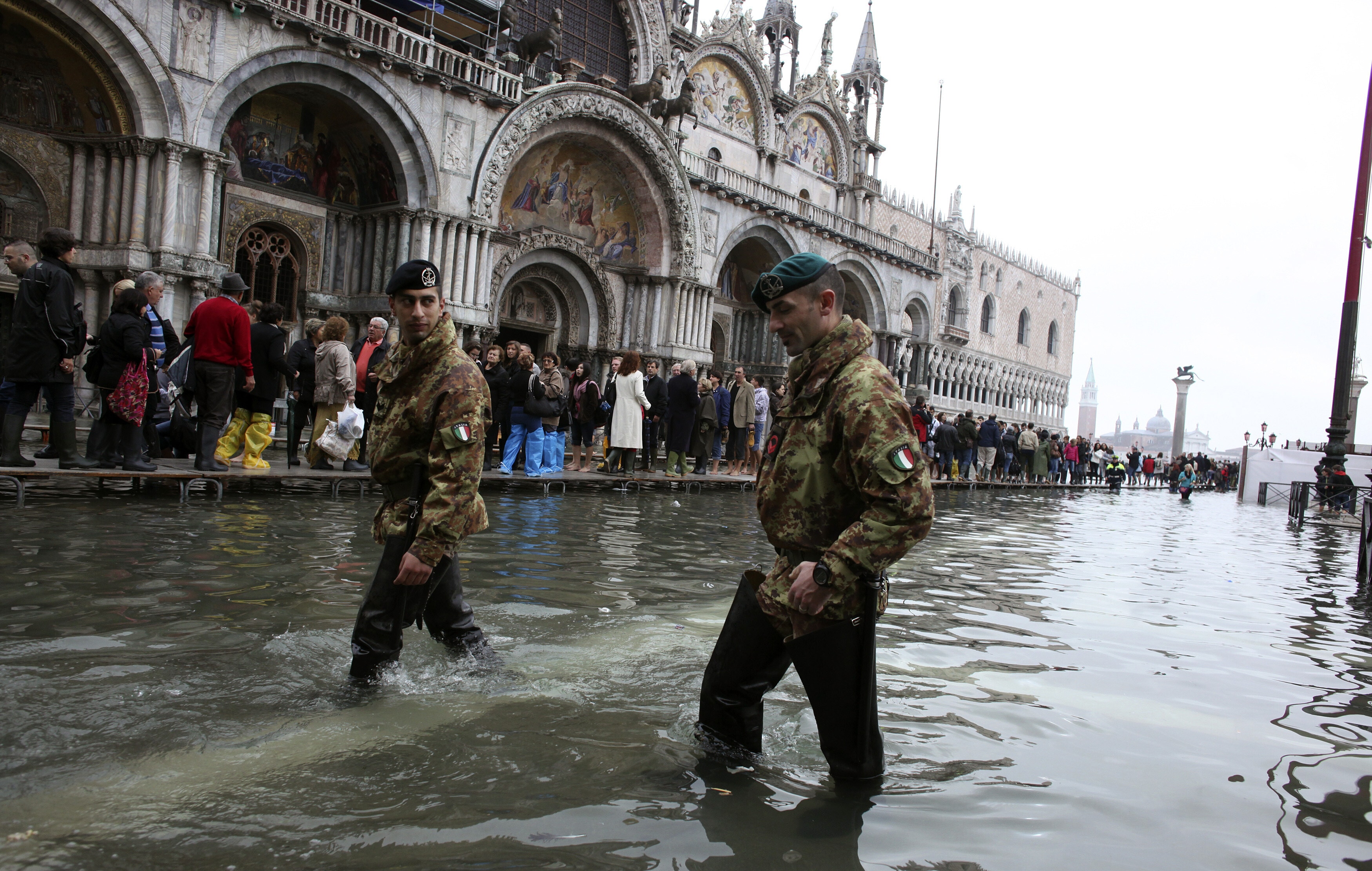Old ideas about nuclear arms control no longer work. We need a fresh approach for the New Nuclear Age

Why is there a sense of disquiet when nuclear weapon stockpiles have shrunk compared to the Cold War? Image: REUTERS/Bazuki Muhammad
This article is part of the World Economic Forum's Geostrategy platform
The Doomsday Clock was set up in Chicago in 1947 by a group of scientists associated with the US project to make the first nuclear bomb. Now, an international group of eminent scientists re-calibrates it annually after assessing the dangers posed to humanity from unrestrained scientific and technological advances.
In 1991, as the Cold War ended, it was moved to 17 minutes to midnight, the farthest it has ever been from doomsday. Since then, it has gradually moved closer and now stands at a scary two minutes to midnight.
Prima facie, it is difficult to reconcile this pessimism with ground reality. After all, nuclear weapons have never been used since 1945, though there have been some pretty close misses, arising from deliberate escalation of tensions (as in the 1962 Cuban missile crisis), or out of misperceptions and miscalculations (as in the 1983 Able Archer crisis). Nevertheless, the convention has held for 75 years. This should strengthen the nuclear taboo.

Global nuclear stockpiles are at an all-time low. The two nuclear super-powers that had accumulated a total of over 70,000 nuclear weapons have reduced their operational arsenals to less than 4,000, though further reductions seem unlikely today.
The Nuclear Non-Proliferation Treaty (NPT) which entered into force in 1970 with 50 countries was extended indefinitely and unconditionally in 1995 and 190 countries have signed up to it. Only four countries remain outside the NPT; India, Pakistan and Israel that never signed it and North Korea which withdrew from it in 2003.
Many Western scholars who coined the term “Second Nuclear Age” also made dire predictions which have not materialised. According to Paul Bracken, “1998 (when India and Pakistan tested) was the turning point”. He correctly pointed out that “it is a second age because it has nothing to do with the central fact of the first nuclear age, the cold war”.
While this observation was valid, the conclusions drawn from it were not. Bracken predicted the “breakdown of the major power monopoly over the bomb”. Kenneth Waltz believed that nuclear weapons would spread. while John Mearsheimer anticipated further proliferation in Europe.
The expectation was that since further proliferation was inevitable, the West should seek to manage it gradually to ensure a degree of stability. After North Korea formally withdrew from the NPT in 2003, Graham Allison cautioned that “South Korea and Japan would build their own arsenals by the end of the decade”.
But nothing like this happened. There was no cascading effect of the Indian and Pakistani nuclear tests. The uncomfortable reality is that proliferation had already taken place, but the Western nuclear narrative found it more convenient not to acknowledge it and go with its own version. Similarly, North Korea’s regime watched Western military interventions with growing concern and after having given notice to withdraw from the NPT a decade earlier, finally withdrew in 2003 after President Bush clubbed it as part of the ‘axis of evil’. Clearly, Western analysts misread the drivers of political behaviour in non-Western countries.
Hysterical nationalism
Another Western assumption was that old rules of deterrence would no longer apply in the new nuclear states as they were guided by “hysterical nationalism” and their motivations would be less transparent and rational. According to them, the US’s arsenal was for defensive purposes, but the new nuclear states were likely to employ their nuclear weapons for offensive purposes.
This was interpreted as justification for preventive wars to serve counter-proliferation objectives as in the case of Iraq or non-state actors seeking to acquire weapons of mass destruction. It also justified greater investment in missile defence for “tailored deterrence”. Paul Bracken darkly questioned if it was “possible for countries to survive the second nuclear age”.
Once again, reality has turned out differently.
It is true that India and Pakistan have had crises after 1998 but have hardly behaved recklessly or more irresponsibly than the two nuclear superpowers.
North Korea accelerated its nuclear and missile development programme under Kim Jong-un but these capabilities have not made it more aggressive in the region. Before the JCPOA was concluded, many Western analysts doubted if Iran would ever accept the onerous constraints on its programme and even today, Iranian restraint stands out in sharp contrast to US unilateralism in walking away from the JCPOA.
What explains the disconnect between Western analyses and the realities of the second nuclear age? Why is there a sense of disquiet when nuclear weapon stockpiles have shrunk compared to the Cold War, proliferation floodgates have not opened up and the NPT enjoys near global adherence?
What explains the perception that deterrence was more stable during the Cold War? Does the fact that the Cold War ended in a victory for the West colour Western perceptions of the Cold War in retrospect? Is Western nostalgia for a return to the Cold War, or actually for the brief moment of unipolarity which followed the collapse of USSR? As the moment of unipolarity has passed, have we moved from the Second Nuclear Age into a New Nuclear Age?
Tied to the past
To understand it, some of the underlying assumptions of the Cold War and deterrence need revisiting. Perhaps Western nostalgia for the Cold War comes because its historical memory is coloured with the tints of ‘certainty’. Yet the reality is that the nuclear button was often in less than safe hands. Under investigation for Watergate in the early 1970s, President Nixon was often troubled by black moods and bouts of heavy drinking which had led NSA Henry Kissinger and Defence Secretary Schlesinger to direct the strategic forces to crosscheck any orders from the White House.
Soviet General Secretary Leonid Brezhnev was subject to periods of forgetfulness, possibly dementia, while French President Georges Pompidou was undergoing sedative treatment for an undisclosed cancer. Mao’s view about nuclear war was that China had the population to overcome its losses of a few hundred million lives, but a nuclear war would be the death of capitalism.
Paul Bracken rightly defines the Cold War as the key attribute of the first nuclear age. Its logical corollary is that as bipolarity governed the first nuclear age, it reduced strategic stability to nuclear stability. Consequently, a certain model of arms control emerged – deterrence stability based on mutual vulnerability and Mutually Assured Destruction, arms race stability because the two nuclear superpowers enjoyed nuclear parity and symmetry, and crisis management which was tested from time to time but fortunately survived the Cold War.
Nuclear multipolarity has come to stay and it is marked not by parity but by asymmetry.
Though this did not qualify as ‘stability’ then’, it perhaps does in Western hindsight. Many Western nuclear experts insist that deterrence maintained nuclear peace. Of course, proving the reality of the negative by its absence has been a philosophical paradox for centuries.
However, this model of arms control no longer holds because nuclear multipolarity has come to stay and it is marked not by parity but by asymmetry.
The Second Nuclear Age was about unipolarity and transitioning from a unipolar moment to a New Nuclear Age, the US neither accepts mutual vulnerability (except perhaps vis-a-vis Russia) nor Mutually Assured Destruction. The problem is that the bipolar model is the only model of arms control that Western analysts know and since it has worked for the West, in providing stability and ensuring victory, it is often sought to be imposed on the emerging strategic rivalries of the 21st century.
If vastly reduced nuclear arsenals today do not provide reassurance, the reason is that these reductions were only measures to manage the arms race and did nothing to diminish the salience of nuclear weapons in the security calculus of the US and the Soviet Union. A myth was however created that arms control or arms limitation would lead to disarmament and it is difficult to let go of it. Today, growing salience of nuclear weapons is a reality despite lower numbers.
Old approaches
In an age of asymmetry, bean counting of launchers and warheads doesn’t work. Verification too poses challenges because doctrinal asymmetry may well depend on ambiguity. The link between nuclear stability and strategic stability gets broken. Old approaches that led to the SALT and START processes helped during the Cold War but today’s political dynamics (even between US and its strategic rivals Russia and China) have changed.
Hand-wringing about the demise of the INF Treaty is pointless because the truth is that the political rationale for it no longer carries conviction.
The West justified the jettisoning of the Anti-Ballistic Missile Treaty in 2002 on the grounds that missile defences were needed to counter rogue regime threats. However, Russia interpreted it as a sign of weakening deterrence. Similarly, the US developed conventional prompt global strike capabilities to convey reduced salience on nuclear weapons, but Russia and China saw it as an attempt to perpetuate technological supremacy. This is why old notions of arms control cannot work.
Limits of success
The 120 non-nuclear weapon states who pushed through the negotiations on the Nuclear Weapons Prohibition Treaty (NWPT) in 2017 are all party to the NPT. However, they had concluded that despite near universal adherence, the NPT could never be the vehicle for nuclear disarmament, one of its stated objectives. The NPT had delegitimized proliferation but did little to delegitimize nuclear weapons. And in doing so, it had reached the limits of its success. The NWPT negotiations were led by the unarmed and boycotted by those who had nuclear weapons, exposing the inherent tensions within the NPT.
Nuclear threats for the West had never quite disappeared except briefly during the unipolar moment, but now they have returned. Addressing these requires acknowledging the limitations of existing arms control in the face of changing political realities.
Instead, the West keeps peddling the old stuff while indulging in nostalgia about mythical stability during the Cold War. Perhaps, the West’s failure to understand the New Nuclear Age is the real reason for today’s nuclear pessimism.
The West’s failure to understand the New Nuclear Age is the real reason for today’s nuclear pessimism, Rakesh Sood, the Observer Research Foundation
Don't miss any update on this topic
Create a free account and access your personalized content collection with our latest publications and analyses.
License and Republishing
World Economic Forum articles may be republished in accordance with the Creative Commons Attribution-NonCommercial-NoDerivatives 4.0 International Public License, and in accordance with our Terms of Use.
The views expressed in this article are those of the author alone and not the World Economic Forum.
Stay up to date:
Nuclear Security
Forum Stories newsletter
Bringing you weekly curated insights and analysis on the global issues that matter.
More on Resilience, Peace and SecuritySee all
Charles Bourgault and Sarah Moin
August 19, 2025







